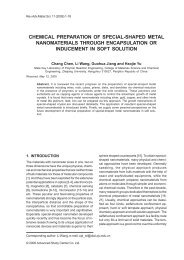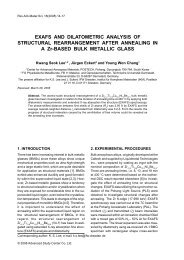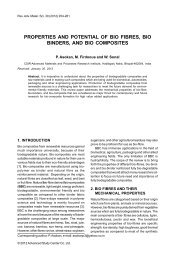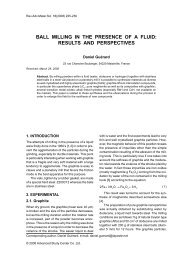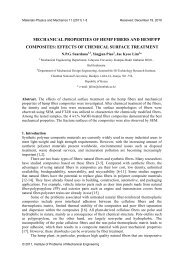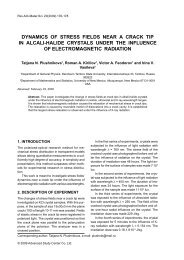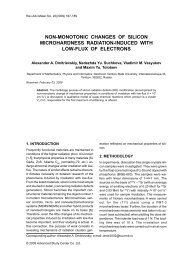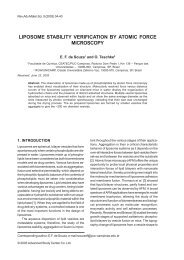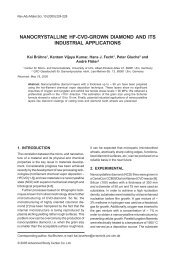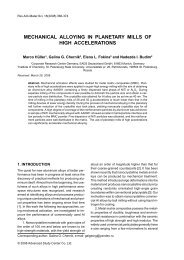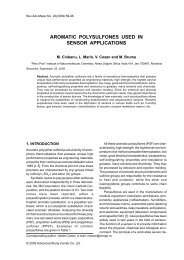surface pretreatment by phosphate conversion coatings – a review
surface pretreatment by phosphate conversion coatings – a review
surface pretreatment by phosphate conversion coatings – a review
Create successful ePaper yourself
Turn your PDF publications into a flip-book with our unique Google optimized e-Paper software.
134 T.S.N. Sankara Narayanan<br />
Table 2. Continued.<br />
13. Thiourea Stabilizer in non- Improved stability of 81<br />
aqueous phosphating the bath<br />
solutions, as inhibitors<br />
14 Sodium lignosulphonate To modify the physical Reduce the tendency 82, 83<br />
form of sludge to form a crust on heat<br />
transfer <strong>surface</strong>s<br />
Improves process<br />
efficiency<br />
15 Methylaminoethoxysilane To prevent rehydration Impart hydrophobic and 84<br />
of <strong>phosphate</strong> dihydrate anti-corrosion properties<br />
16 Hexameta<strong>phosphate</strong> To decrease the <strong>surface</strong> Enables deep drawing 85<br />
roughness and increase of tubes (~50% length)<br />
the extent of absorption with reduction in wall<br />
of sodium sterate thickness<br />
ing use of substitutes to conventional Cr(VI) postrinses<br />
[48] to suit the regulations imposed <strong>by</strong> the<br />
pollution control authorities on the use of Cr(VI) compounds.<br />
The special additives used in phosphating<br />
baths is complied in Table 2 and the alternatives to<br />
Cr(VI) post-rinse treatment is given in Table 3.<br />
3.2. Chemistry of phosphating<br />
All conventional phosphating solutions are dilute<br />
phosphoric acid based solutions of one or more alkali<br />
metal/heavy metal ions, which essentially contain<br />
free phosphoric acid and primary <strong>phosphate</strong>s<br />
of the metal ions contained in the bath<br />
[18,19,24,127,128]. When a steel panel is introduced<br />
into the phosphating solution a topochemical<br />
reaction takes place in which the iron dissolution is<br />
initiated at the microanodes present on the substrate<br />
<strong>by</strong> the free phosphoric acid present in the<br />
bath. Hydrogen evolution occurs at the<br />
microcathodic sites.<br />
Fe + 2H 3 PO 4 → Fe(H 2 PO 4 ) 2 + H 2 ↑ . (1)<br />
The formation of soluble primary ferrous <strong>phosphate</strong><br />
leads to a concurrent local depletion of free acid<br />
concentration in the solution resulting in a rise in<br />
pH at the metal/solution interface. This change in<br />
pH alters the hydrolytic equilibrium which exists<br />
between the soluble primary <strong>phosphate</strong>s and the<br />
insoluble tertiary <strong>phosphate</strong>s of the heavy metal ions<br />
present in the phosphating solution, resulting in the<br />
rapid <strong>conversion</strong> and deposition of insoluble heavy<br />
metal tertiary <strong>phosphate</strong>s [18,19,24,127, 128]. In a<br />
zinc phosphating bath these equilibria may be represented<br />
as:<br />
Zn(H 2 PO 4 ) 2 ⇔ ZnHPO 4 + H 3 PO 4 , (2)<br />
3ZnHPO 4 ⇔ Zn 3 (PO 4 ) 2 + H 3 PO 4 . (3)<br />
A certain amount of free phosphoric acid must<br />
be present to repress the hydrolysis and to keep<br />
the bath stable for effective deposition of <strong>phosphate</strong><br />
at the microcathodic sites. Another factor affecting<br />
the shift in the primary to tertiary <strong>phosphate</strong> equilibria<br />
is the temperature of the bath. Higher temperatures<br />
favour easy precipitation of the tertiary <strong>phosphate</strong>s<br />
in a shorter time. Hence, more amount of<br />
phosphoric acid is needed for the baths operating<br />
at higher temperatures. In contrast, in the case of<br />
phosphating baths operated at room temperature,<br />
the possibility of the increase in acidity during continuous<br />
operation is more likely [129,130] and is<br />
normally neutralised <strong>by</strong> the addition of the carbonate<br />
of the metal which forms the coating (Zn(CO 3 ) 2<br />
in zinc phosphating bath). Hence, depending upon<br />
the working temperatures and the concentrations<br />
of the constituents in the bath, the free phosphoric<br />
acid content must be chosen to maintain the equilibrium<br />
condition. Too much of phosphoric acid not<br />
only delays the formation of the coating, but also<br />
leads to excessive metal loss.<br />
3.3. Acceleration of the phosphating<br />
process<br />
In practice, phosphating reaction tends to be slow<br />
owing to the polarization caused <strong>by</strong> the hydrogen<br />
evolved in the cathodic reaction. In order to achieve<br />
coating formation in a practicable time, some mode<br />
of acceleration must be employed. The importance<br />
of the acceleration of the phosphating process was



